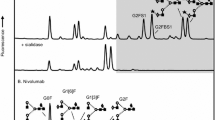Abstract
Engineering the fragment crystallizable (Fc) of human IgG can bring improved effector functions to monoclonal antibodies and Fc-fusion-based medicines and vaccines. Such Fc-effector functions are largely controlled by posttranslational modifications (PTMs) within the Fc, including the addition of glycans that introduce structural and functional heterogeneity to this class of therapeutic. Here, we describe a detailed method to allow the detection of hyper-sialylated Fcs to glycan receptors that will facilitate the future development of new mAbs and Fc-fragment therapies and vaccines.
Access this chapter
Tax calculation will be finalised at checkout
Purchases are for personal use only
Similar content being viewed by others
References
Czajkowsky DM, Hu J, Shao Z et al (2012) Fc-fusion proteins: new developments and future perspectives. EMBO Mol Med 4:1015–1028
Lund J, Takahashi N, Pound JD et al (1996) Multiple interactions of IgG with its core oligosaccharide can modulate recognition by complement and human Fcy receptor I and influence the synthesis of its oligosaccharide chains. J Immunol 157:4963–4969
Dalziel M, Crispin M, Scanlan CN et al (2014) Emerging principles for the therapeutic exploitation of glycosylation. Science 343:1235681. https://doi.org/10.1126/science.1235681
Frank M, Walker RC, Lanzilotta WN et al (2014) Immunoglobulin G1 Fc domain motions: implications for Fc engineering. J Mol Biol 426:1799–1811
Subedi GP, Hanson QM, Barb AW (2014) Restricted motion of the conserved immunoglobulin G1 N-glycan is essential for efficient Fc g RIIIa binding. Structure 22:1478–1488
Schwab I, Nimmerjahn F (2013) Intravenous immunoglobulin therapy: how does IgG modulate the immune system? Nat Rev Immunol 13:176–189
Debre M, Bonnet MC, Fridman WH et al (1993) Infusion of Fc gamma fragments for treatment of children with acute immune thrombocytopenic purpura. Lancet 342:945–949
Washburn N, Schwab I, Ortiz D et al (2015) Controlled tetra-Fc sialylation of IVIg results in a drug candidate with consistent enhanced anti-inflammatory activity. Proc Natl Acad Sci U S A 112:E1297–E1306
Anthony RM, Kobayashi T, Wermeling F et al (2011) Intravenous gammaglobulin suppresses inflammation through a novel T(H)2 pathway: commentary. Nature 475:110–113
Anthony RM, Wermeling F, Karlsson MCI et al (2008) Identification of a receptor required for the anti-inflammatory activity of IVIG. Proc Natl Acad Sci U S A 105:19571–19578
Liu L (2015) Antibody glycosylation and its impact on the pharmacokinetics and pharmacodynamics of monoclonal antibodies and Fc-fusion proteins. J Pharm Sci 104:1866–1884
Li H, Sethuraman N, Stadheim TA et al (2006) Optimization of humanized IgGs in glycoengineered Pichia pastoris. Nat Biotechnol 24:210–215
St-Amour I, Pare I, Alata W et al (2013) Brain bioavailability of human intravenous immunoglobulin and its transport through the murine blood–brain barrier. J Cereb Blood Flow Metab 33:1983–1992
Finke JM, Ayres KR, Brisbin RP et al (2017) Antibody blood-brain barrier efflux is modulated by glycan modification. Biochim Biophys Acta 1861:2228–2239
Zhang G, Lopez PHH, Li CY et al (2004) Anti-ganglioside antibody-mediated neuronal cytotoxicity and its protection by intravenous immunoglobulin: implications for immune neuropathies. Brain 127:1085–1100
Fiebiger BM, Maamary J, Pincetic A et al (2015) Protection in antibody- and T cell-mediated autoimmune diseases by antiinflammatory IgG Fcs requires type II FcRs. Proc Natl Acad Sci 112:E2385–E2394. https://doi.org/10.1073/pnas.1505292112
Blundell PA, Le NPL, Allen J et al (2017) Engineering the fragment crystallizable (Fc) region of human IgG1 multimers and monomers to fine-tune interactions with sialic acid-dependent receptors. J Biol Chem 292:12994–13007
van de Bovenkamp FS, Hafkenscheid L, Rispens T et al (2016) The emerging importance of IgG Fab glycosylation in immunity. J Immunol 196:1435–1441
Author information
Authors and Affiliations
Corresponding author
Editor information
Editors and Affiliations
Rights and permissions
Copyright information
© 2019 Springer Science+Business Media, LLC, part of Springer Nature
About this protocol
Cite this protocol
Blundell, P., Pleass, R. (2019). A Method to Detect the Binding of Hyper-Glycosylated Fragment Crystallizable (Fc) Region of Human IgG1 to Glycan Receptors. In: Steinitz, M. (eds) Human Monoclonal Antibodies. Methods in Molecular Biology, vol 1904. Humana Press, New York, NY. https://doi.org/10.1007/978-1-4939-8958-4_20
Download citation
DOI: https://doi.org/10.1007/978-1-4939-8958-4_20
Published:
Publisher Name: Humana Press, New York, NY
Print ISBN: 978-1-4939-8957-7
Online ISBN: 978-1-4939-8958-4
eBook Packages: Springer Protocols




